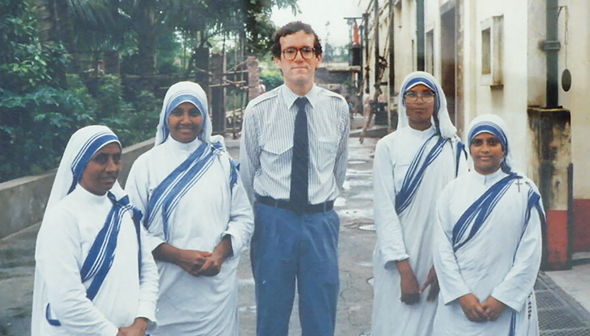by Frank DeRosa

When Dr. George V. Lombardi traveled to Rome for the Sept. 4 canonization of Blessed Teresa of Calcutta, he carried with him the memory of two women Religious whose impact on him was life-changing: one, his parochial school teacher in Queens; the other, the founder of the Missionaries of Charity herself.
Dr. Lombardi, an internist and expert in infectious diseases, has become known as the physician whose skills and judgement saved the life of now-St. Teresa of Calcutta during a critical medical crisis in 1989. And the seeds for his profession were planted in the sixth grade at St. Anastasia School, Douglaston by a Sister of Mercy, of the Dallas, Pa., community, who stimulated his scientific curiosity.
“I used to ride my bike from our home on Deepdale Avenue to and from school,” Dr. Lombardi remembers. “Sometimes I’d ride by the marshes in Douglaston Manor and collect mollusks, crabs and pond water and carry them to school.” There Sister Marietta would set up a simple mirror-and-light microscope for him to peer into the world of interesting species.
Describing the sister as “intellectually rigorous,” he said “she took an interest in me.” It eventually led to his winning the Diocesan Science Fair in the late 1960s, putting together styrofoam balls and pipe cleaners to create an intricate three-foot molecular model of the DNA double helix that impressed the judges and earned him the top prize. “Sister Marietta was very encouraging,” he said.
First Steps
Proving once again that the influence of a good teacher, as the Sister of Mercy was, can spark creative young minds into pursuing productive careers, the small science experiments at St. Anastasia’s were the first steps the youthful Lombardi took toward a lifetime of helping the ill and distressed.
Then-Mother Teresa entered his life much later, after he had completed years of medical studies and after research on infectious diseases in East Africa, and as he was building up a practice in an office in Manhattan, near New York Hospital Cornell Medical Center. It began with an unexpected phone call from someone he didn’t know, a woman named Jan Petrie, who had learned of the doctor’s work in Kenya.
Petrie, a Canadian film producer who had done two documentaries on Mother Teresa, asked him if he would visit the revered nun, who lay in the intensive care unit of a Calcutta hospital, suffering from a life-threatening condition; she was debilitated by a high fever that would not go down, and by nausea and the vomiting of blood. Her Indian doctors were deeply concerned.
The unassuming 32-year-old doctor gasped at the sudden turn of events in his life created by the phone call. How could he say no to Petrie’s urgent request? He couldn’t, of course, and he didn’t.
After a series of whirlwind activities – beginning with a conference call with the doctors in Calcutta, then involving the U.S. passport office, India’s consul general in Manhattan and the actions of resourceful Missionaries of Charity, all orchestrated by Petrie – a day later he was aboard a Concorde flight en route to an unusual house call. (Dr. Lombardi vividly describes it all in a YouTube video, “The Moth: Mission to India.”)
Off to Calcutta
Arriving in Calcutta, he conferred again with Mother Teresa’s cardiologists. “They were worried,” he said, because “her condition was deteriorating.” He examined her, taking the appropriate blood cultures, stains and smears. A pacemaker had been implanted in her left chest several months earlier, inserted as a precaution because of her weak heart.
Dr. Lombardi said he saw a glimmer of hope for her recovery, however, when the report on the blood cultures came back. It showed she was in septic shock with a bacterial cause due to the pacemaker. He concluded that it should be removed. Mother Teresa’s doctors, as well as a cardiologist summoned from Rome, opposed the diagnosis. They feared public humiliation if this person of international acclaim were to be lost during the pacemaker removal.
The Indian physicians anxiously deliberated Dr. Lombardi’s recommendation and its possible fatal consequence. Finally, they somewhat reluctantly accepted his decision, the Italian doctor still firmly against it. They said, however, that he would have to remove the pacemaker himself. The young doctor had never done it before.
With understandable apprehension, he approached the procedure warily. He found, however, that the pacemaker came out readily enough. He also discovered that a catheter attached to it remained wedged in the right ventricle. A wrong move could make a hole and in minutes she could bleed to death.
Prayed to Mother Teresa
A serious complication. Patiently, he struggled to dislodge the wire. He wanted and needed help, he said, so “I prayed to Mother Teresa for Mother Teresa.” The wire came out. A short time later, the fever subsided and the 79-year-old missionary to the poor survived and went on to live another eight years.
Dr. Lombardi maintains a connection with the Missionaries of Charity in the South Bronx as their physician. Recently, a young Sister told him that he represents a link to the religious community’s past. “Dr. Lombardi,” she said, “we in the convent think of you as a rock star.”
“They are wonderful people, very sweet,” he said. “They do God’s work.” The same sentiment could be applied to him. On some future date he plans to go to Lourdes as a Knight of Malta to attend to the needs of the sick and disabled.
As for now, Dr. Lombardi, who also attended the beatification in 2003, was thrilled to witness the canonization at St. Peter’s. And he says he is grateful for the arc that has connected him from Sister Marietta of Douglaston to St. Teresa of Calcutta.
DeRosa is the retired director of the Public Information Office of the Diocese of Brooklyn.

I enjoyed your Moth story very much. I am wondering at this time of the pandemic if you have something written or some public commentary?